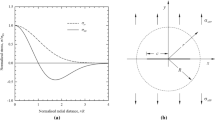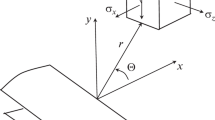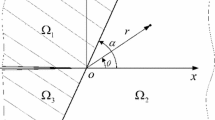Abstract
The initiation of fracture is studied for an internally cracked large plate. The cracked plate is subjected to biaxial loading with different ratios of the normal load to the lateral load. The initiation of crack propagation is predicted by using a strain based mechanism of fracture. It is shown that the normal load required for fracturing a linear elastic material drops significantly when the lateral load increases beyond a critical value.
Similar content being viewed by others
References
Chang. K.J. (1981). On the maximum strain criterion-A new approach to the angled crack problem. Engineering Fracture Mechanics, 14. 107-124.
Fischer, K.F. and Goldner, H. (1981). On the formation of a principal strain in crack fracture mechanics. International Journal of Fracture. 17, R3-R6.
Haefele, P.M. and Lee J.D. (1995). The constant stress term. Engineering Fracture Mechanics. 50, No 5/6, 869-882.
Kibler, J.J. and Roberts, R. (1970). The effect of biaxial stresses on fatigue and fracture. Journal of Engineering for Industry, 727-734.
Maiti, S.K. and Smith, R.A. (1984). Criteria for brittle fracture in biaxial tension. Engineering Fracture Mechanics. 19(5), 793-804.
Viola, E. and Piva, A. (1984). Crack paths in sheets of brittle material. Engineering Fracture Mechanics. 19(6), 1069-1084.
Author information
Authors and Affiliations
Rights and permissions
About this article
Cite this article
Ayatollahi, M. On Biaxially Loaded Internal Cracks. International Journal of Fracture 109, 9–14 (2001). https://doi.org/10.1023/A:1010990207560
Issue Date:
DOI: https://doi.org/10.1023/A:1010990207560




